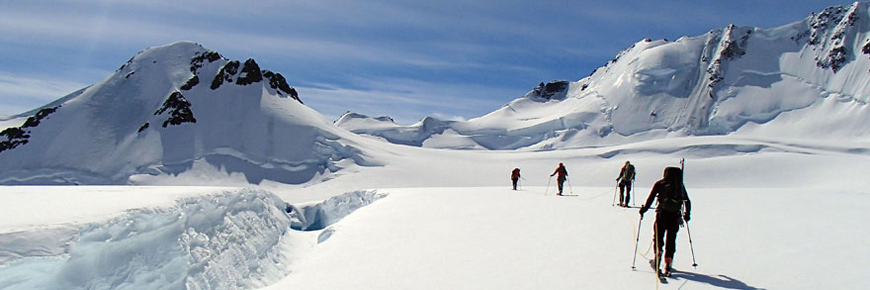
Expedition logistics
Kluane National Park and Reserve
An ascent of any of the taller mountains requires extensive glacier travel and anywhere from 10 days to three weeks of climbing depending on the route chosen, weather and snow conditions. Plan ahead. Select a trip which suits your party and ensure that you are properly equipped for your trip.
Covid-19
You must follow all applicable federal and Yukon territorial travel requirements.
Self-isolation is not permitted within Kluane National Park and Reserve and, if required by territorial authorities, must be completed prior to your arrival.
Business and service providers, such as mountaineering guides, commercial film operations, and research organizations, are required to have a COVID-19 operation plan in place while operating in the Yukon.
There are currently border restrictions for discretionary travel into Canada.
Insurance
Insurance is required for all expeditions in the Icefield Ranges.
Climbing season
The climbing season generally extends from mid-April to late June.
The 2021 climbing season commences on April 10. Permits for travel in the Icefield Ranges are not issued after November 15.
Please note that closures can occur at any time.
Minimum group size – Mount Logan
Mount Logan is the highest peak in Canada and accounts for the majority of incidents in Kluane National Park and Reserve. Due to the increased risks associated with solo climbing at high altitude, for both climbers and response staff, a minimum group size of two people is required for expeditions attempting Mount Logan.
Guiding services
For those seeking the services of a guide, a list of licensed mountaineering companies for Kluane National Park and Reserve is available. Please contact Kluane National Park and Reserve.
Business and service providers, such as mountaineering guides, commercial film operations, and research organizations, are required to have a COVID-19 operation plan in place while operating in the Yukon.
Access
Access into the Icefield Ranges requires an hour or more aircraft flight or one to two weeks of overland travel from the nearest road.
Aircraft access

An aircraft landing permit must be obtained for each and every landing within the Icefields.
Both helicopters and light fixed wing aircraft on ski-wheels are normally available in Yukon at the:
- Whitehorse Airport
- Haines Junction Airport
- Kluane Lake Research Station
- Burwash Landing Airport.
Access to the border of Kluane National Park and Reserve is available from Alaska at the:
- Haines Airport
- Chitina River at Ultima Thule Lodge
It is recommended that arrangements and reservations be made well in advance. Please contact Kluane National Park and Reserve for the current Aircraft and Ground Transportation list.
Overland access

Ä’äy Chù (Slims River)
Access into or out from the Icefields via the Ä’äy Chù (Slims River) Valley, between April 1st and November 15th requires the use of bear resistant containers for all food, garbage and food wastes. These can be borrowed from the park.
Kaskawulsh and Alsek River valleys
Access into or out from the icefields via the Kaskawulsh and Alsek River Valleys is not permitted between April 1st and November 15th.
Crossing the Yukon - Alaska border
Visitors travelling by foot into Kluane National Park and Reserve from Alaska will not be issued a permit without prior clearance from Canada Border Services Agency (CBSA).
There are currently border restrictions for discretionary travel into Canada: Coronavirus disease (COVID-19): Travel restrictions
For further information contact:
Canada Border Services 1-867-667-3943 or 1-613-948-7878
Visitors intending to enter Alaska from Kluane National Park and Reserve will be required to obtain prior approval from U.S. Customs & Border Protection. Call:
U.S. Customs & Border Protection in Haines, Alaska: 1-907-767-5511
Low impact mountaineering
Low impact mountaineering practices are critical to the future of the wilderness attributes that have made Kluane National Park and Reserve world famous.
- Carry out what you carried in
- Do not leave fixed line, glacier wands, food caches or broken equipment in the icefields
- Reduce packaging prior to entering the icefields
- Do not burn garbage in the icefields
- Human feces should be buried as deep as possible in pit privies or deposited into crevasses
Related links
- Date modified :